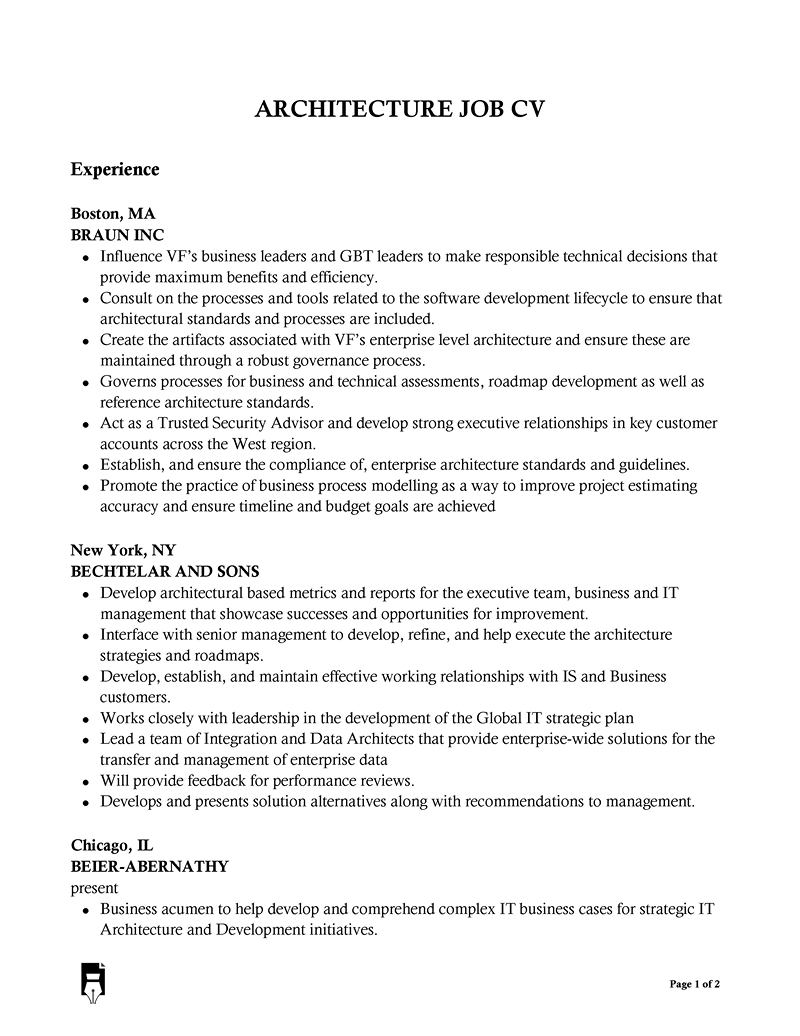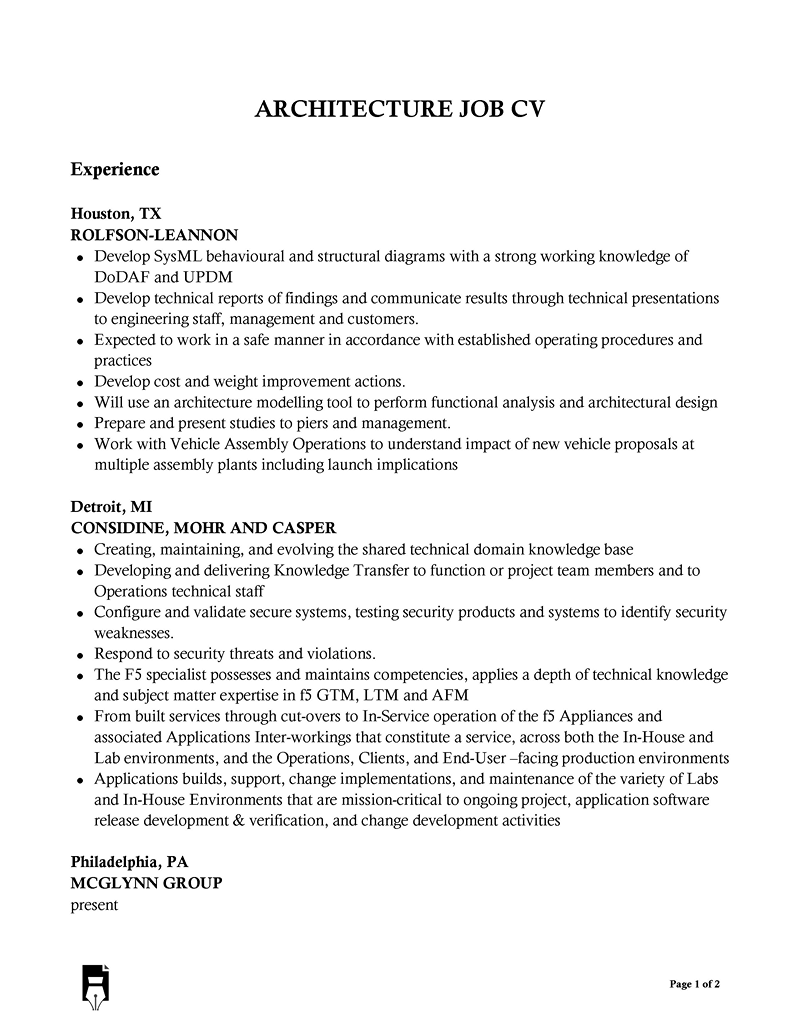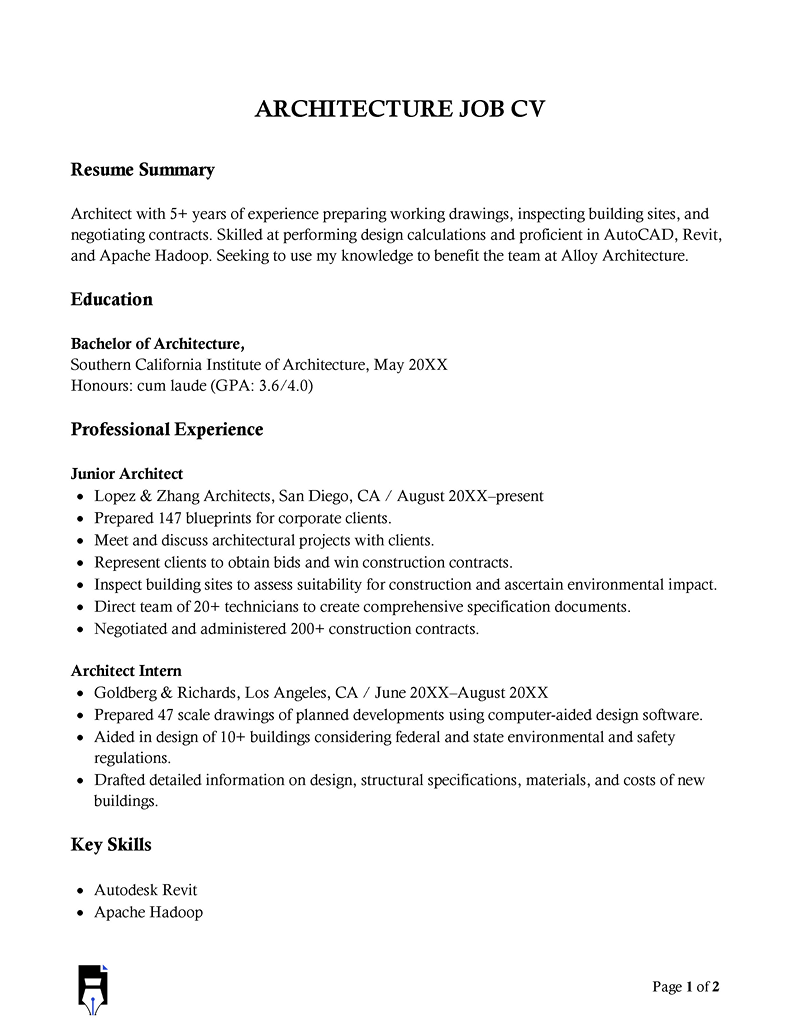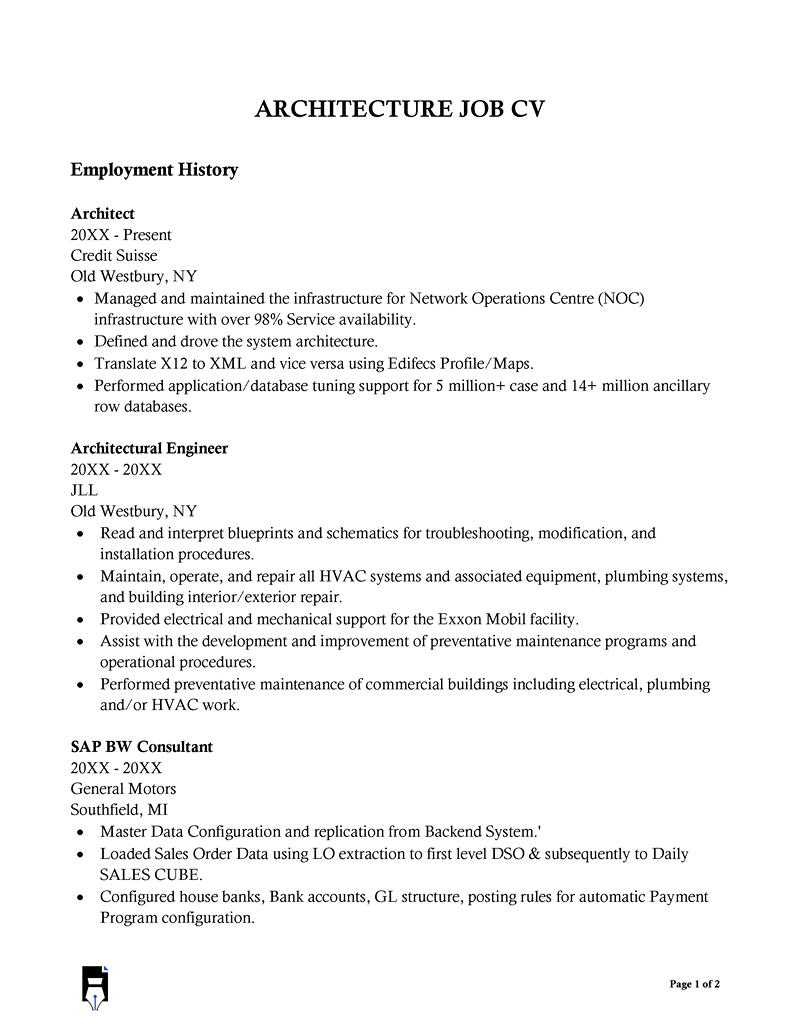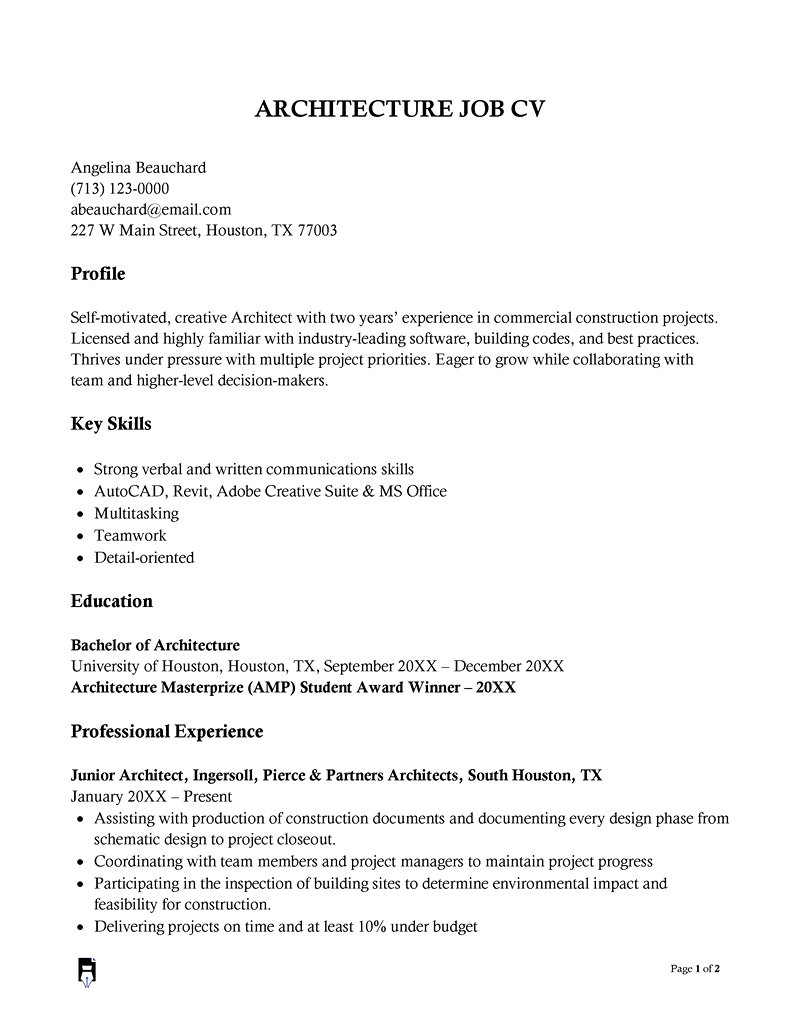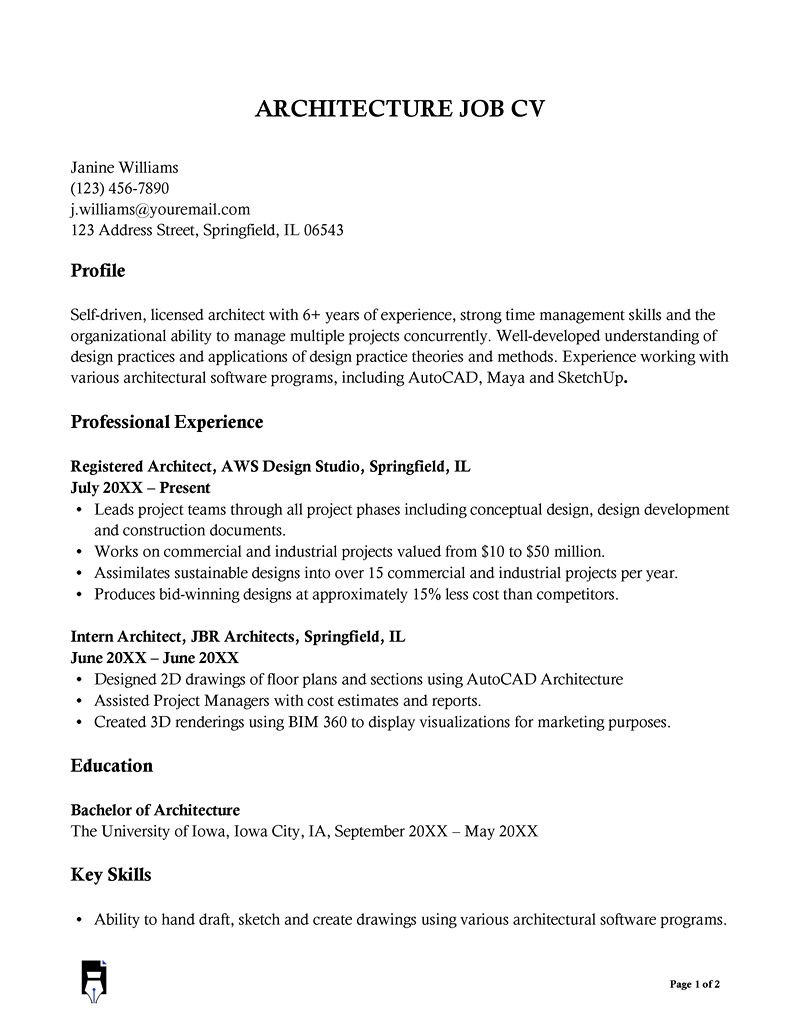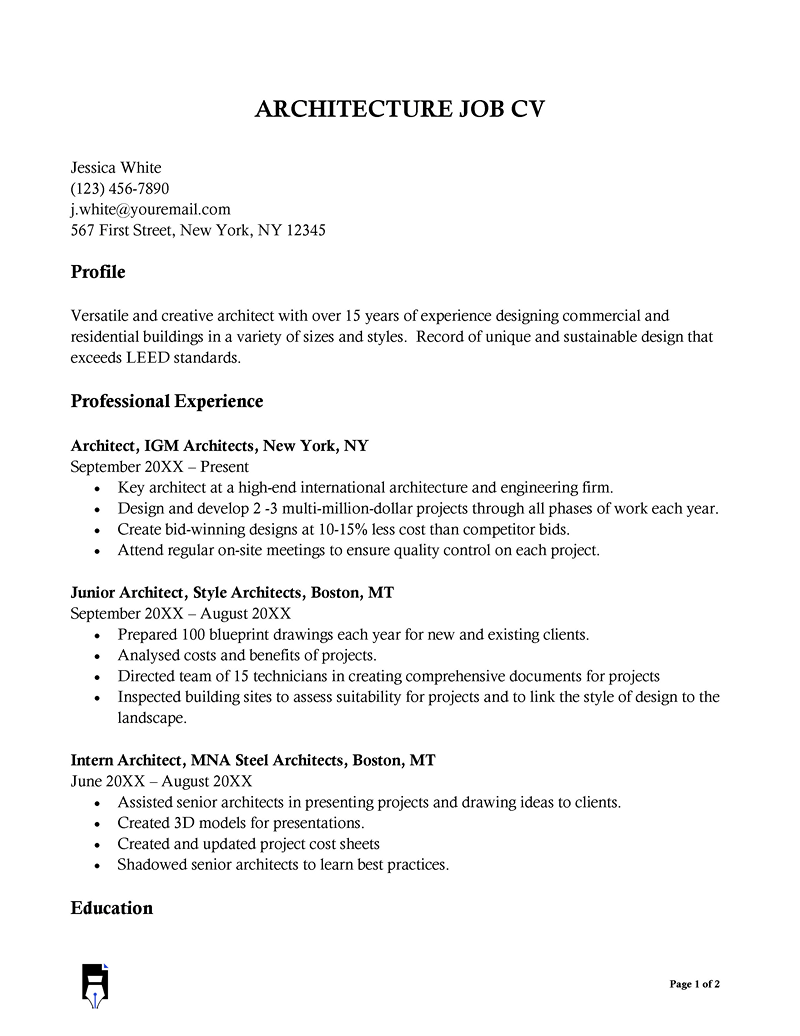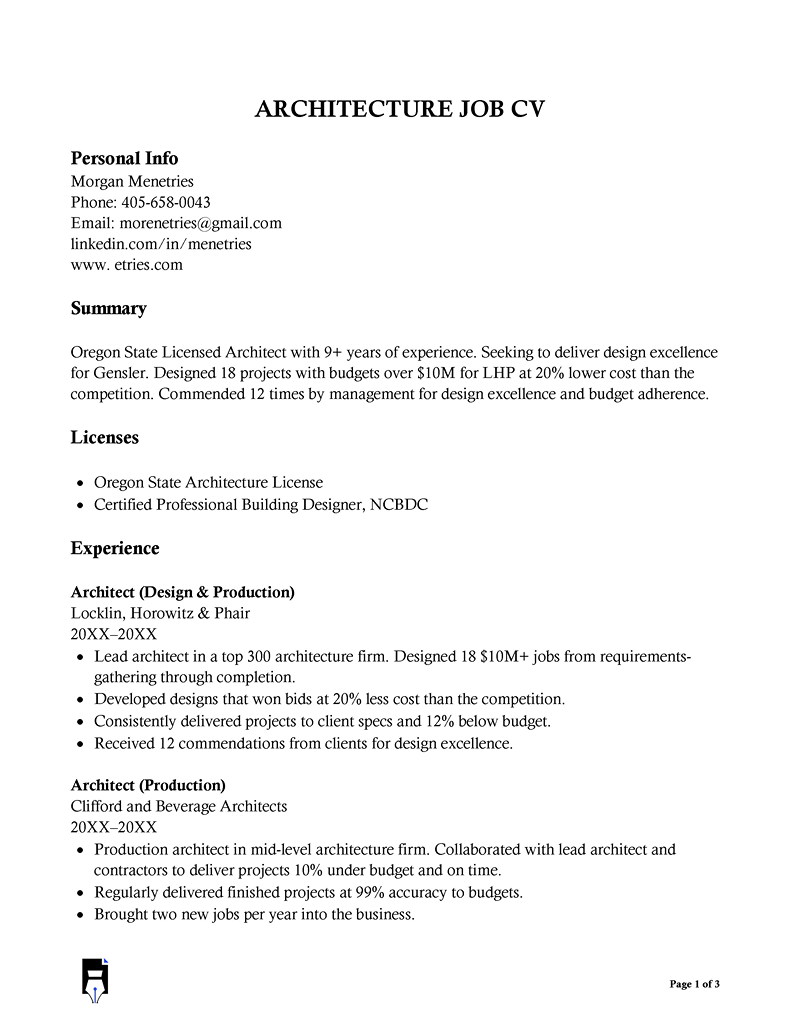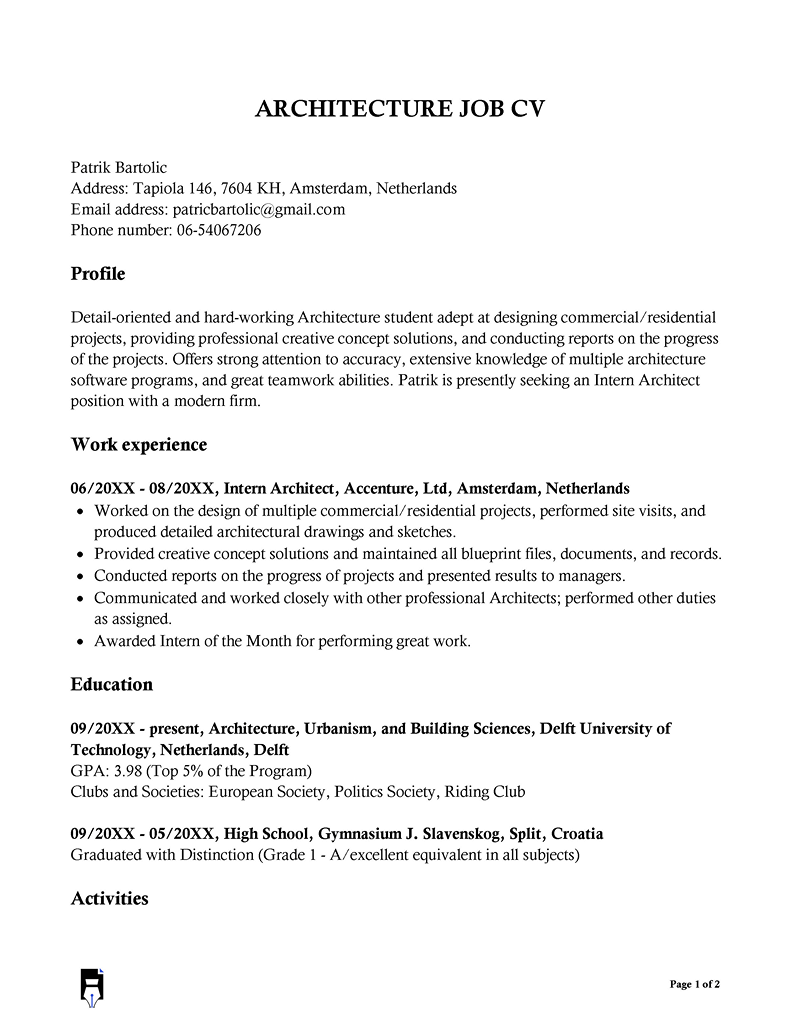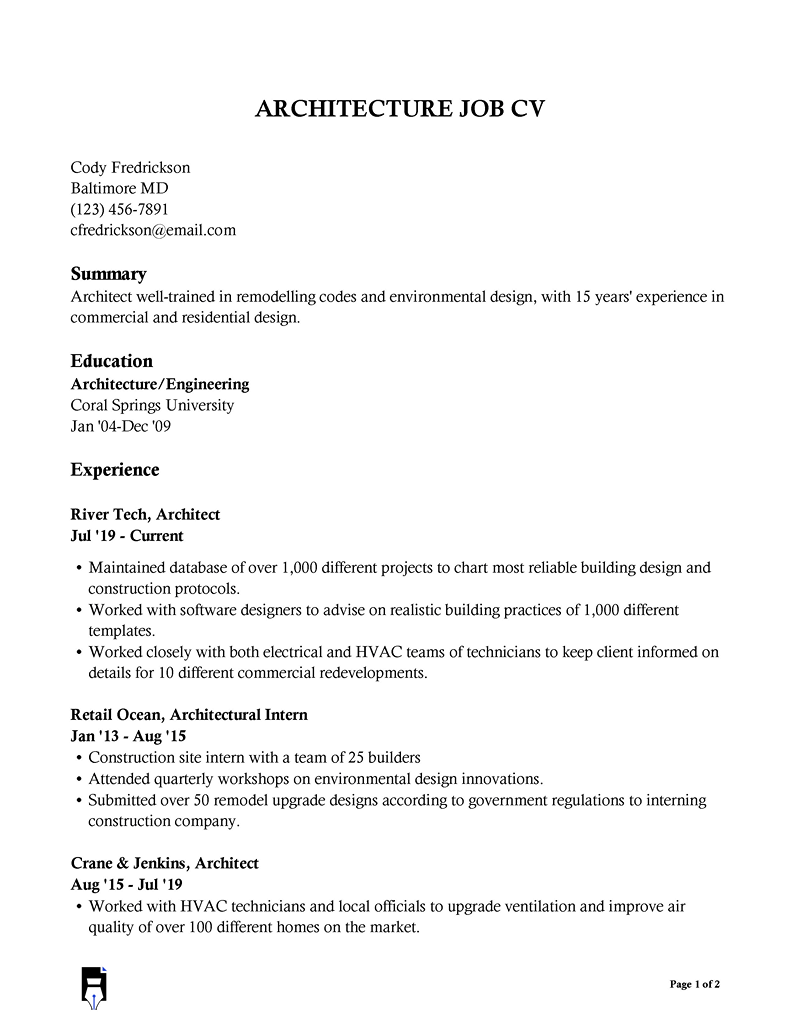A resume is an official document that you can use to outline and highlight your qualifications, skills, experiences, and accomplishments when you apply for a job. The resume is important as it allows you to share your vision and qualifications with the employer. For this purpose, when applying for an architect position, it is important to create a resume that will convince the hiring manager that you are the perfect candidate for the job. It should highlight the benefits you will bring to the company and also focus on the professional and personal aspects that make you a qualified candidate for the job.
In this article, you will learn about the following aspects of writing an Architect Resume.
- The responsibilities of an architect
- Selecting an appropriate format
- How to make your resume ATS compliant
- A step-by-step guide on how to prepare a resume
- Do’s and don’ts for writing an effective resume
Current trends in the job market for architects: The job market for architects is highly competitive. That means you need to have a strong resume to capture the employer’s attention. According to Data USA (Architecture and engineering occupations | Data USA), the number of students graduating in this field is growing at a rate of 4.68% annually. However, the projected number of architectural jobs will increase by at least 1% every year for the next ten years. Thus, more than ever, a well-drafted resume is very important to stand out from the rest of the competition.
Free Templates: Architect Resumes
It is best to use a template to ensure that you write an effective resume that contains all the required details. A template will guide you on the sections you should include on your architect resume. It will also make your work easier and faster. You can access excellent templates on this website. They are free to download, easy to use, and can be customized to suit your needs.
Responsibilities of an Architect
Architects are mainly responsible for designing and constructing structures within the community. Note that there are different architectural specializations that one can major in; these include industrial, commercial, residential, and commercial. The duties of an architect might vary depending on the project at hand.
However, some common responsibilities include the following:
- To discuss the specifics and purpose of a project with a client.
- To envision the project and develop designs that will be used to make the visualization a reality.
- To gain legal documentation and permission to begin working on the project.
- Collaborate with designers, engineers, and contractors to make the project successful.
- To consider the project’s needs and make any necessary adjustments to fit the economic requirements of the project.
Selecting an Appropriate Format
Using a format that allows you to present yourself professionally is essential. The format should allow you to include all the necessary and relevant information.
The choice of format will depend on your unique career profile. You can use a functional resume if you are a recent graduate and have little experience. A combination resume is suitable if you have a few years of architectural experience or are changing careers. This format is a good mix of skills and experience and presents you as a mid-career professional. A chronological resume is recommended if you have vast work experience and no career gaps. This format is suitable when applying for senior positions.
Here are some things to consider when creating and formatting your resume:
- Use headers to separate various parts of your resume.
- Keep it brief and relevant and not more than 1 page in length.
- Use a standard font size of 11-12 points. Also, choose a font style that will make your document look professional and formal.
- Save it in MS word or PDF format.
- Also, tailor your document to match each specific job opening and organization you apply to.
- Use a template that will allow you to include all your expertise and experience accurately.
- Proofread it and correct any spelling and grammar errors before submitting it to the hiring manager.
Note: Explore different templates to make your resume more appealing and professional. You can use various styles, such as simple, creative, professional, and modern. You can customize them to suit your needs.
How to Make Your Resume ATS Compliant?
An Applicant Tracking System (ATS) is a software application used by large organizations that receive many job applications to scan applicants’ resumes. This software program helps hiring managers select resumes containing relevant keywords that match the job description and discard unsuitable ones.
Here are some tips to consider if you want your resume to be ATS-compliant.
- Include keywords mentioned in the job description. These keywords should appear in the skills and summary sections.
- Format and structure your resume in a way that is readable by the ATS. This allows the ATS to scan your resume with ease.
- Do NOT use special graphics, images, or symbols as it might confuse the ATS.
Step-by-Step Guide to Write an Architect’s Resume
It is important to know the required details that must be included in your document to prepare a convincing resume. Here is a step-by-step guide that highlights the specific sections that must be included in your resume:
Write your contact details
Start by including your contact details, which should include the following:
- Your name and surname
- Professional title
- Phone number
- Your email
- Your address or location
- Link to a professional website or online portfolio
You must include accurate details in this section, as that is the only way your prospective employer can contact you. Also, errors and typographical errors in this section will likely discourage the recruiter from reading the entire document.
Example:
Philip Maxwell
Architect
222-222-222
[email protected]
maxwellphilip.linkedin.com
912 Higher Roads, BA
Write your profile statement
The profile statement of an architect’s resume can be written in two ways: as a resume summary or objective. It all depends on the level of experience you have as a job candidate.
Resume summary
This is a brief statement highlighting your work experience. It focuses on your achievements in your previous workplaces and the top skills you used to succeed. Ensure that you mention the following:
- Years of experience
- Top skills
- Professional highlights or achievements.
For example:
A detail-oriented, artistic, and innovative residential architect with five years of experience. Was an active team member of the Mega Milano House Project for government social workers. A great communicator with knowledge of Autodesk AutoCAD Civil 3D, land development laws, and building codes.
Resume objective
A resume objective is a concise statement that focuses on the following:
- Your skill set
- Educational background
- Career goals
This profile statement is most suitable for students or recent graduates with little to no work experience. And you can focus more on what makes you outstanding and better than other applicants. You can include your hopes for working for the company you are applying to and how your education and skills will benefit them.
For example:
A strong-willed and determined recent graduate who desires to create safe homes using future technology. With a master’s degree in Architecture and knowledge of design and construction, the idea is to create homes that support a green lifestyle to reduce negative environmental impacts. To leverage my technical knowledge and creativity to contribute to the success of a dynamic architecture firm.
Include an employment history section
The third part is the employment history, where you should highlight your responsibilities and achievements from your previous jobs. This is an essential section of your resume, as it will help the recruiter determine your suitability for the position. It is a crucial section in which to showcase your professional experience and qualifications to potential employers. This section must be compelling and provide a thorough overview of your work experience.
Ensure that you include the following details for every position that you held:
- Your work title
- Company name
- Employment date
- 3-5 top achievements/responsibilities, in bullet points
Focus more on your achievements than responsibilities in this section if you want to impress the hiring manager and stand out among other job applicants.
For example:
Residential Architect
ABC Company (November 2019- Present)
–Successfully communicated with clients to effectively and timely realize their visions
–Successfully headed the project to add more green spaces in industrial areas, decreasing air pollution by 10% in one year
–Managed a team of 9 interns and recent graduates training to be architects
Tips for writing this section
Here are some tips that you should observe when writing the employment history section:
- Only mention relevant experience based on the job description.
- Explain your achievements in detail such as the techniques or strategies you have used and the results you obtained.
- Use action words, such as spearheaded, accomplished, or managed, and the active voice to highlight your achievements.
- Quantify your achievements using concrete numbers, percentages, and statistics to make your experience more credible and convincing.
What if you do not have work experience?
You would not have accumulated substantial work experience if you are a recent graduate or an entry-level candidate. If this is the case, your resume should focus on your education and academic projects, which express your passion for the job. You can write this section easily by following the tips below:
- Include your academic and personal architecture projects
- Mention your school contests where you participated/won
- Provide details of any freelance jobs you may have done
- Mention any internships
List your education
The education section should have the following details:
- Your highest degree
- Name of the university and its location
- Attendance years
- Either your high school degree or any other advanced degree
For example:
Bachelor’s Degree in Architecture
Highland University, River Road
September 2016 – December 2020
As an entry-level candidate, you can also mention relevant academic achievements that will boost your profile. This includes accomplishments such as graduating first in your class or receiving any award related to your final year project, etc. Ensure that you list your most recent degree first in this section. You can also mention your CGPA, but only if it is 3.0 or above. Also, avoid including your high school degree if you have a higher degree.
List your hard and soft skills
The next part is the skills section, where you should mention your hard and soft skills. Keep in mind that, apart from your work experience, your hard or technical skills are of immense significance for hiring managers. However, it does not undermine the importance of soft skills, which are also valuable for any job. Additionally, avoid listing generic skills and only include the ones that you possess.
For this section, it is vital to include relevant skills that will help you get the job. You can achieve this by only highlighting those that are relevant to the job description and the architectural industry.
Here are some examples of soft skills and hard skills that you can include in your resume:
Soft skills:
- Creativity
- Problem-Solving
- Critical Thinking
- Confidence
- Punctuality
- Collaboration
- Active Listening
- Perseverance
- Empathy
- Presentation Skills
- Written & Oral Communication
- Public Speaking
- Intercultural Competence
- Patience
- Decision-making
Hard skills:
- Adobe Creative Cloud Suite
- Sketchup Pro
- Autodesk Revit
- Windows & OSX Operating systems
- Model Building
- Dark Room Techniques
- Sketching
- Autodesk AutoCAD
- 3D Design
- Hand Drafting
- ArcGIS
- Microsoft Office
- Google Drive/Docs
- Basic Web Development
- Digital + Film Photography
Include additional sections
For the final part of your architect resume, you can add the additional sections as shown below:
- Awards and certifications: Mention any awards or certifications.
- Conferences: You can mention any conferences you attended to show your passion and interest in the profession. Conferences show that you were eager to learn more about your field and want to start abreast of all the latest developments.
- Accolades/recognitions: Include any accolades you received from your previous jobs such as a best planner or designer etc.
- Languages: If you speak any foreign language(s), ensure that you include it. It is always beneficial to mention your language skills in any job especially ones that require customer interactions as you will be able to instantly connect with foreign clients or get a job in a multicultural organization.
- Hobbies and interests: You can also include your hobbies and interests to showcase your personality by showing the recruiter what you do during your free time.
- Projects: To boost your resume, you should mention 1 or 2 of your best architecture projects.
This section is important as it will help you stand out among the rest of the candidates, especially those with similar qualifications. Also, it will make your resume more diverse and exciting, portraying you as a unique and dedicated individual.
For example:
–Awards and Certifications
System Architect Certifications
Uptown Institution, 2019
–Languages
English (native),
French (full working proficiency)
Germany (basic working proficiency)
Dutch (basic working proficiency)
–Conferences
Architectural International Conference, 2021
–Hobbies and Interests
Playing video games
Physical activities like hiking and working ou
Painting and Photography
Do’s and Don’ts for Writing an Architect Resume
A hiring manager will only be interested in your application if it stands out and is easy to read. There are some do’s and don’ts that you should keep in mind if you want to write an impeccable resume.
Here are some of the do’s and don’ts to consider when creating your resume to apply as an architect:
The Do’s
To ensure you have an effective and appealing resume, do the following:
Quantify your achievements
It is crucial to mention and quantify your achievements; this makes it easy for the prospective employer to understand your expertise and skills.
Review before submitting
Basic spelling or grammar errors show your lack of attention and unprofessional attitude. Therefore, proofreading your documents before sending them will help you ensure that they are error-free.
Use action verbs
Use action verbs when listing your accomplishments and roles in previous companies. Word choice is important to describe what you have done and persuade potential employers to give you an interview. Examples of action verbs that you can use to describe your achievements as an architect include the following:
- Developed
- Overhauled
- Created
- Achieved
- Assigned
- Established
- Designed
Use columns
Using columns will make your resume look neat and professional. Additionally, columns make it easier for you to arrange your information. As a result, the hiring manager will quickly locate relevant information. Therefore, ensuring that each column has a distinct and clear header is vital.
Focus on the top half of the resume
It is crucial to place your most impressive and significant achievements in the top half of your resume. This is because most hiring managers pay the utmost attention to that section. Therefore, any vital information should be mentioned using headers in the first half of your resume.
Mirror the company colors on your profile
Another important tip is to incorporate the company’s colors and the fonts used on its website into your resume. This shows the hiring manager that you have paid attention to the organization and displays your creativity and understanding as an architect as well.
The Don’ts
Ensure that you avoid the following to have an excellent resume for an architect’s position:
Making it over long
Your resume should be short and succinct. Avoid using long sentences and only highlight your qualifications, skills, expertise, and experiences. This allows the hiring manager to review your resume quickly and not miss any important information. Try not to exceed more than 1 page in length.
Submitting one resume for each job
Each architecture firm has its own mission and requirements, so avoid using the same resume to apply for different jobs. For every job application, study the potential employer’s requirements thoroughly and customize your document accordingly.
Frequently Asked Question
How should you tailor your resume for a specific job opening?
The easiest approach to tailoring your resume is to ensure that you use the keywords mentioned in the job description. Like this, you can customize your skills and work section to match the qualifications required by the employer.
